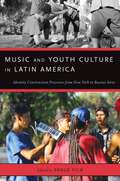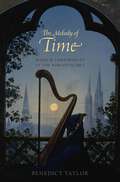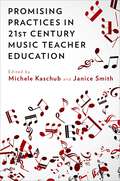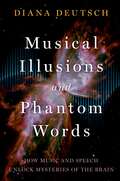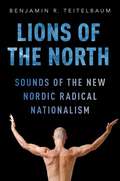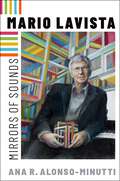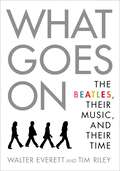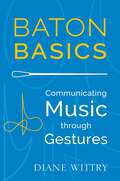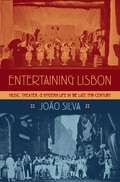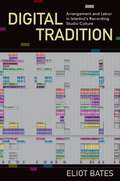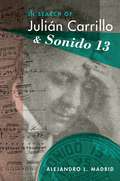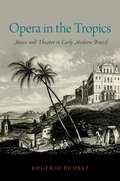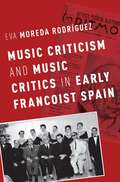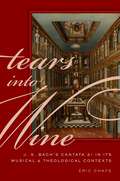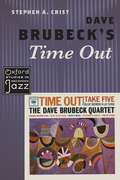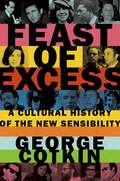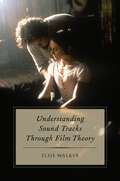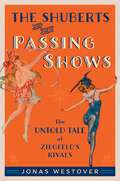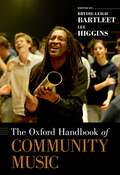- Table View
- List View
Music and Youth Culture in Latin America: Identity Construction Processes from New York to Buenos Aires (Currents in Latin American and Iberian Music)
by Pablo VilaMusic is one of the most distinctive cultural characteristics of Latin American countries. But, while many people in the United States and Europe are familiar with musical genres such as salsa, merengue, and reggaetón, the musical manifestations that young people listen to in most Latin American countries are much more varied than these commercially successful ones that have entered the American and European markets. Not only that, the young people themselves often have little in common with the stereotypical image of them that exists in the American imagination. Bridging this divide between perception and reality, Music and Youth Culture in Latin America brings together contributors from throughout Latin America and the US to examine the ways in which music is used to advance identity claims in several Latin American countries and among Latinos in the US. From young Latin American musicians who want to participate in the vibrant jazz scene of New York without losing their cultural roots, to Peruvian rockers who sing in their native language (Quechua) for the same reasons, to the young Cubans who use music to construct a post-communist social identification, this volume sheds new light on the complex ways in which music provides people from different countries and social sectors with both enjoyment and tools for understanding who they are in terms of nationality, region, race, ethnicity, class, gender, and migration status. Drawing on a vast array of fields including popular music studies, ethnomusicology, sociology, and history, Music and Youth Culture in Latin America is an illuminating read for anyone interested in Latin American music, culture, and society.
The Melody of Time: Music and Temporality in the Romantic Era
by Benedict TaylorFrom the Romantic era onwards, music has been seen as the most quintessentially temporal art, possessing a unique capacity to invoke the human experience of time. Through its play of themes and recurrence of events, music has the ability to stylise in multiple ways our temporal relation to the world, with far-reaching implications for modern conceptions of memory, subjectivity, personal and collective identity, and history. Time, as philosophers, scientists and writers have found throughout history, is notoriously hard to define. Yet music, seemingly bound up so intimately with the nature of time, might well be understood as disclosing aspects of human temporality unavailable to other modes of inquiry, and accordingly was frequently granted a privileged position in nineteenth-century thought. The Melody of Time examines the multiple ways in which music relates to, and may provide insight into, the problematics of human time. Each chapter explores a specific theme in the philosophy of time as expressed through music: the purported timelessness of Beethoven's late works or the nostalgic impulses of Schubert's music; the use of music by philosophers as a means to explicate the aporias of temporal existence or as a medium suggestive of the varying possible structures of time; and, a reflection of a particular culture's sense of historical progress or the expression of the intangible spirit behind the course of human history itself. Moving fluidly between cultural context and historical reception, competing philosophical theories of time and close reading of the repertoire, Benedict Taylor argues for the continued importance of engaging with music's temporality in understanding the significance of music within society and human experience. At once historical, analytical, critical, and ultimately hermeneutic, The Melody of Time provides both fresh insight into many familiar nineteenth-century pieces and a rich theoretical basis for future research.
Promising Practices in 21st Century Music Teacher Education
by Michele Kaschub and Janice SmithThis book surveys emerging music and education landscapes to present a sampling of the promising practices of music teacher education that may serve as new models for the 21st century. Contributors explore the delicate balance between curriculum and pedagogy, the power structures that influence music education at all levels, the role of contemporary musical practices in teacher education, and the communication challenges that surround institutional change. Models of programs that feature in-school, out-of-school and beyond school contexts, lifespan learning perspectives, active juxtapositions of formal and informal approaches to teaching and learning, student-driven project-based fieldwork, and the purposeful employment of technology and digital media as platforms for authentic music engagement within a contemporary participatory culture are all offered as springboards for innovative practice.
Musical Illusions and Phantom Words: How Music and Speech Unlock Mysteries of the Brain
by Diana DeutschIn this ground-breaking synthesis of art and science, Diana Deutsch, one of the world's leading experts on the psychology of music, shows how illusions of music and speech--many of which she herself discovered--have fundamentally altered thinking about the brain. These astonishing illusions show that people can differ strikingly in how they hear musical patterns--differences that reflect variations in brain organization as well as influences of language on music perception. Drawing on a wide variety of fields, including psychology, music theory, linguistics, and neuroscience, Deutsch examines questions such as: When an orchestra performs a symphony, what is the "real" music? Is it in the mind of the composer, or the conductor, or different members of the audience? Deutsch also explores extremes of musical ability, and other surprising responses to music and speech. Why is perfect pitch so rare? Why do some people hallucinate music or speech? Why do we hear phantom words and phrases? Why are we subject to stuck tunes, or "earworms"? Why do we hear a spoken phrase as sung just because it is presented repeatedly? In evaluating these questions, she also shows how music and speech are intertwined, and argues that they stem from an early form of communication that had elements of both. Many of the illusions described in the book are so striking and paradoxical that you need to hear them to believe them. The book enables you to listen to the sounds that are described while reading about them.
Musical Illusions and Phantom Words: How Music and Speech Unlock Mysteries of the Brain
by Diana DeutschIn this ground-breaking synthesis of art and science, Diana Deutsch, one of the world's leading experts on the psychology of music, shows how illusions of music and speech--many of which she herself discovered--have fundamentally altered thinking about the brain. These astonishing illusions show that people can differ strikingly in how they hear musical patterns--differences that reflect variations in brain organization as well as influences of language on music perception. Drawing on a wide variety of fields, including psychology, music theory, linguistics, and neuroscience, Deutsch examines questions such as: When an orchestra performs a symphony, what is the "real" music? Is it in the mind of the composer, or the conductor, or different members of the audience? Deutsch also explores extremes of musical ability, and other surprising responses to music and speech. Why is perfect pitch so rare? Why do some people hallucinate music or speech? Why do we hear phantom words and phrases? Why are we subject to stuck tunes, or "earworms"? Why do we hear a spoken phrase as sung just because it is presented repeatedly? In evaluating these questions, she also shows how music and speech are intertwined, and argues that they stem from an early form of communication that had elements of both. Many of the illusions described in the book are so striking and paradoxical that you need to hear them to believe them. The book enables you to listen to the sounds that are described while reading about them.
Lions of the North: Sounds of the New Nordic Radical Nationalism
by Benjamin R. TeitelbaumOften labeled "neo-Nazis" or "right-wing extremists," radical nationalists in the Nordic countries have always relied on music to voice their opposition to immigration and multiculturalism. These actors shook political establishments throughout Sweden, Denmark, and Norway during the 1980s and 1990s by rallying around white power music and skinhead subculture. But though nationalists once embraced a reputation for crude chauvinism, they are now seeking to reinvent themselves as upstanding and righteous, and they are using music to do it. Lions of the North explores this transformation of anti-immigrant activism in the Nordic countries as it manifests in thought and sound. Offering a rare ethnographic glimpse into controversial and secretive political movements, it investigates changes in the music nationalists make and patronize, reading their puzzling embrace of lite pop, folk music, even rap and reggae as attempts to escape stereotypes and craft a new image for themselves. Lions of the North not only exposes the dynamic relationship between music and politics, but also the ways radical nationalism is adapting to succeed in some of the most liberal societies in the world.
Mario Lavista: Mirrors of Sounds (Currents in Latin American and Iberian Music)
by Ana R. Alonso-MinuttiThis is an open access title available under the terms of a CC BY-NC-ND 4.0 International license. It is free to read at Oxford Scholarship Online and offered as a free PDF download from OUP and selected open access locations. Composer, pianist, editor, writer, and pedagogue Mario Lavista (1943-2021) was a central figure of the cultural and artistic scene in Mexico and one of the leading Ibero-American composers of his generation. His music is often described as evocative and poetic, noted for his meticulous attention to timbre and motivic permutation, and his creative trajectory was characterized by its intersections with the other arts, particularly poetry and painting. Lavista was a relational composer; he did not write music as a private enterprise but for and alongside people with whom he established close relations. Understanding analysis as an affective practice, author Ana R. Alonso-Minutti explores the intertextual connections between the multiple texts--musical or otherwise--that are present in Lavista's music. Alonso-Minutti argues that, through adopting an interdisciplinary and transhistorical approach to music composition, Lavista forged a cosmopolitan imaginary that challenged stereotypes of what Mexican music should sound like. This imaginary becomes a strategy of resistance against imperialist agendas placed upon postcolonial peripheries. Departing from traditional biographical and chronological frameworks that exalt masters and masterworks, the author offers a nuanced, personal narrative informed by conversations with composers, performers, artists, choreographers, poets, writers, and filmmakers. Through an innovative mosaic of methodologies, from archival work, to musical and intertextual analysis, oral history, and (auto)ethnography, this book is the first in-depth study of Lavista's compositional career and offers a contextual panorama of the contemporary music scene in Mexico
What Goes On: The Beatles, Their Music, and Their Time
by Walter Everett Tim RileyIn a stretch of just seven years, the Beatles recorded hundreds of songs which tower above those of their worthy peers as both the product of cultural leadership and an artistic reflection of their turbulent age, the1960s. Walter Everett and Tim Riley's What Goes On: The Beatles, Their Music, and Their Time blends historical narrative, musicology, and music analysis to tell the full story of the Beatles and how they redefined pop music. The book traces the Beatles' development chronologically, marking the band's involvement with world events such as the Vietnam War, strides in overcoming racial segregation, gender stereotyping, student demonstrations, and the generation gap. It delves deeply into their body of work, introducing the concepts of musical form, instrumentation, harmonic structure, melodic patterns, and rhythmic devices in a way that is accessible to musicians and non-musicians alike. Close readings of specific songs highlight the tensions between imagination and mechanics, songwriting and technology, and through the book's musical examples, listeners will learn how to develop strategies for creating their own rich interpretations of the potential meanings behind their favorite songs. Videos hosted on the book's companion website offer full definitions and performance demonstrations of all musical concepts discussed in the text, and interactive listening guides illustrate track details in real-time listening. The unique multimedia approach of What Goes On reveals just how great this music was in its own time, and why it remains important today as a body of singular achievement.
Baton Basics: Communicating Music through Gestures
by Diane WittryBaton Basics offers a unique approach to teaching conducting based upon the concept of conveying weight, resistance, and energy in order to communicate a better concept of musical sound to the musicians. Featuring many detailed drawings and access to over 60 video examples on the companion website, Baton Basics guides conductors away from simply marking beat patterns, and towards a nuanced and phrased musicality that can be communicated to a group of musicians. Baton Basics is a key foundational text for the student and experienced conductor alike, and is a must read for anyone interested in improving and expanding their vocabulary of conducting gestures.
Entertaining Lisbon: Music, Theater, and Modern Life in the Late 19th Century (Currents in Latin American and Iberian Music)
by Joao SilvaDuring the decades leading up to 1910, Portugal saw vast material improvements under the guise of modernization while in the midst of a significant political transformation - the establishment of the Portuguese First Republic. Urban planning, everyday life, and innovation merged in a rapidly changing Lisbon. Leisure activities for the citizens of the First Republic began to include new forms of musical theater, including operetta and the revue theater. These theatrical forms became an important site for the display of modernity, and the representation of a new national identity. Author João Silva argues that the rise of these genres is inextricably bound to the complex process through which the idea of Portugal was presented, naturalized, and commodified as a modern nation-state. Entertaining Lisbon studies popular entertainment in Portugal and its connections with modern life and nation-building, showing that the promotion of the nation through entertainment permeated the market for cultural goods. Exploring the Portuguese entertainment market as a reflection of ongoing negotiations between local, national, and transnational influences on identity, Silva intertwines representations of gender, class, ethnicity, and technology with theatrical repertoires, street sounds, and domestic music making. An essential work on Portuguese music in the English language, Entertaining Lisbon is a critical study for scholars and students of musicology interested in Portugal, and popular and theatrical musics, as well as historical ethnomusicologists, cultural historians, and urban planning researchers interested in the development of material culture.
Digital Tradition: Arrangement and Labor in Istanbul's Recording Studio Culture
by Eliot BatesIstanbul is home to a multimillion dollar transnational music industry, which every year produces thousands of digital music recordings, including widely distributed film and television show soundtracks. Today, this centralized industry is responding to a growing global demand for Turkish, Kurdish, and other Anatolian ethnic language productions, and every year, many of its top-selling records incorporate elaborately orchestrated arrangements of rural folksongs. What accounts for the continuing demand for traditional music in local and diasporic markets? How is tradition produced in twenty-first century digital recording studios, and is there a "digital aesthetics" to contemporary recordings of traditional music? In Digital Traditions: Arrangement and Labor in Istanbul's Recording Studio Culture, author Eliot Bates answers these questions and more with a case study into the contemporary practices of recording traditional music in Istanbul. Bates provides an ethnography of Turkish recording studios, of arrangers and engineers, studio musicianship and digital audio workstation kinesthetics. Digital Traditions investigates the moments when tradition is arranged, and how arrangement is simultaneously a set of technological capabilities, limitations and choices: a form of musical practice that desocializes the ensemble and generates an extended network of social relations, resulting in aesthetic art objects that come to be associated with a range of affective and symbolic meanings. Rich with visual analysis and drawing on Science & Technology Studies theories and methods, Digital Traditions sets a new standard for the study of recorded music. Scholars and general readers of ethnomusicology, Middle Eastern studies, folklore and science and technology studies are sure to find Digital Traditions an essential addition to their library.
In Search of Julián Carrillo and Sonido 13 (Currents in Latin American and Iberian Music)
by Alejandro L. MadridIn the 1920s, the Mexican composer Julián Carrillo (1875-1965) developed a microtonal system called El Sonido 13 (The 13th Sound). Although his pioneering role as one of the first proponents of microtonality within the Western art music tradition elevated Carrillo to iconic status among European avant-garde circles in the 1960s and 1970s, his music and legacy have remained largely overlooked by music scholars, critics, and performers. Confronting this paucity of scholarship on Carrillo and his music, Alejandro L. Madrid goes above and beyond "filling in" the historical record. Combining archival and ethnographic research with musical analysis and cultural theory, Madrid argues that Carrillo and Sonido 13 are best understood as a cultural complex: a network of moments, spaces, and articulations in which Carrillo and his music continuously re-acquire significance and meaning. Thus, Madrid explores Carrillo's music and ideas not only in relation to the historical moments of their inception, but also in relation to the various cultural projects that kept them alive and re-signified them through the beginning of the twenty-first century. Eschewing traditionally linear historical frameworks, In Search of Julián Carrillo and Sonido 13 employs an innovative transhistorical narrative in which past, present, and future are explored dialogically in order to understand the politics of performance and self-representation behind Carrillo and Sonido 13. In Search of Julián Carrillo and Sonido 13 transforms the traditional genre of the composer study, treating it not as a celebration of "masters" and "masterworks," but as a pointed postcolonial intervention that offers invaluable insight into the politics of cultural exchange, experimentalism, marginality, and cultural capital in twentieth century Mexico.
Opera in the Tropics: Music and Theater in Early Modern Brazil (Currents in Latin American and Iberian Music)
by Rogério BudaszOpera in the Tropics is an engaging exploration of theater with music in Brazil from the mid 1500s to the early 1820s. Author Rogério Budasz delves into the practices of the actors, singers, poets, and composers who created and performed Jesuit moral plays, Spanish comedias, and Portuguese vernacular operas and entremezes during the colonial period, as well as the Italian operas that celebrated the new independent nation in 1822. A Brazilian producer claimed in 1825 that the goal of music-theater was to instruct, entertain, and distract the population. Budasz argues that this threefold goal had in fact been present throughout the colonial period, in different combinations and with different purposes, at the hands of missionaries, intellectuals, bureaucrats, political leaders, and cultural producers. While Budasz demonstrates a continuity from Portuguese theatrical practices, primarily through the circulation of artists and repertory, he also examines a number of localized departures from the metropolitan model, particularly in the ethnic and gender profile of theatrical workers, in the modifications determined by local tastes, priorities, and materials, and in the political use of theater as an ideological and civilizing tool within the paradoxical context of a slave society. An eye-opening narrative of the transformations and uses of a colonial art form, Opera in the Tropics will be essential reading for all interested in the music and theater in Iberian and Latin American culture.
Music Criticism and Music Critics in Early Francoist Spain (Currents in Latin American and Iberian Music)
by Eva Moreda RodriguezThe early years of the Franco regime saw the formation of a strong governmental propaganda apparatus. Through expansive press laws that solidified state control over public and private media outlets alike, the Franco government directly influenced what information was made available to the public. While music critics and journalists were by no means free from government control and direction, music criticism under the Franco regime did not adhere to any official party "line" on music. Indeed, music criticism often demonstrated a diversity of opinion and ideological belief that runs counter to many common assumptions about journalism under fascist regimes. In Music Criticism and Music Critics in Early Francoist Spain, Eva Moreda Rodríguez presents a kaleidoscopic portrait of the diverse and often divergent writings of music critics in the early years of the Franco regime. Although she does not shy away from the thorny issues of propaganda and censorship, Moreda Rodríguez considers other factors that shaped the journalistic discourse surrounding music. Political rivalries, ideological diversity within musical "conservatism," as well as the explicit and implicit expectations of the Franco government all influenced the diverse landscape of music criticism. Moreover, the central issues that music critics were concerned with during Francoism's early years-modernist music, Spanish early music, traditional music, and music's role in organizing the state-had already been at the center of debates within the press for several decades. Carefully selecting contemporary writings by well-known music critics, Moreda Rodríguez contextualizes music criticism written during the Franco regime within the broader intellectual history of Spain from the nineteenth century onwards. The first critical study of the musical press of Francoist Spain in the broader cultural and social fabric of the regime, Music Criticism and Music Critics in Early Francoist Spain is an essential resource for musicologists interested in 20th-century Spain, as well as Hispanists interested in the early Franco regime.
Tears into Wine: J. S. Bach's Cantata 21 in its Musical and Theological Contexts
by Eric ChafeIn 1714, the 29 year-old Johann Sebastian Bach was promoted to the position of concertmaster at the ducal court of Weimar. This post required him for the first time in his already established career to produce a regular stream of church cantatas-one cantata every four weeks. Among the most significant works of this period is Ich hatte viel Bekümmernis in meinem Herzen (Cantata 21). Generally known in English as "I had much affliction," Cantata 21 draws from several psalms and the Book of Revelations and offers a depiction of the spiritual ascent of the soul from intense tribulation to joy and exaltation. Although widely performed and loved by musicians, Cantata 21 has endured much criticism from scholars and critics who claim that the piece lacks organizational clarity and stylistic coherence. In Tears into Wine, renowned Bach scholar Eric Chafe challenges the scholarly consensus, arguing that Cantata 21 is an exceptionally carefully designed work, and that it displays a convergence of musical structure and theological purpose that is paradigmatic of Bach's sacred work as a whole. Drawing on a wide range of Lutheran theological writing, Chafe shows that Cantata 21 reaches beyond the scope of the individual liturgical occasion to voice a breadth of meaning that encompasses much of the core of Lutheran thought. Chafe artfully demonstrates that instead of simply presenting a musical depiction of the soul's journey from sorrow to bliss, Cantata 21 expresses the various stages of God's revelation and their impact on the believing soul. As a result, Chafe reveals that Cantata 21 has a formal design that mirrors Lutheran belief in unfolding revelation, with the final movement representing the work's "crown"--the goal toward which all of the earlier movements are directed. Complete with full text translations of the cantata and the liturgical readings that would have accompanied it at the first performance, Tears into Wine is a monumental book that is ideally suited for Bach scholars and students, as well as those generally interested in the relationship between theology and music.
Dave Brubeck's Time Out (Oxford Studies in Recorded Jazz)
by Stephen A. CristDave Brubeck's Time Out ranks among the most popular, successful, and influential jazz albums of all time. Released by Columbia in 1959, alongside such other landmark albums as Miles Davis's Kind of Blue and Charles Mingus's Mingus Ah Um, Time Out became one of the first jazz albums to be certified platinum, while its featured track, "Take Five," became the best-selling jazz single of the twentieth century, surpassing one million copies. In addition to its commercial successes, the album is widely recognized as a pioneering endeavor into the use of odd meters in jazz. With its opening track "Blue Rondo à la Turk" written in 9/8, its hit single "Take Five" in 5/4, and equally innovative uses of the more common 3/4 and 4/4 meters on other tracks, Time Out has played an important role in the development of modern jazz. In this book, author Stephen A. Crist draws on nearly fifteen years of archival research to offer the most thorough examination to date of this seminal jazz album. Supplementing his research with interviews with key individuals, including Brubeck's widow Iola and daughter Catherine, as well as interviews conducted with Brubeck himself prior to his passing in 2012, Crist paints a complete picture of the album's origins, creation, and legacy. Couching careful analysis of each of the album's seven tracks within historical and cultural contexts, he offers fascinating insights into the composition and development of some of the album's best-known tunes. From Brubeck's 1958 State Department-sponsored tour, during which he first encountered the Turkish aksak rhythms that would form the basis of "Blue Rondo à la Turk," to the backstage jam session that planted the seeds for "Take Five," Crist sheds an exciting new light on one of the most significant albums in jazz history.
DAVE BRUBECK'S TIME OUT OSRJ C (Oxford Studies in Recorded Jazz)
by Stephen A. CristDave Brubeck's Time Out ranks among the most popular, successful, and influential jazz albums of all time. Released by Columbia in 1959, alongside such other landmark albums as Miles Davis's Kind of Blue and Charles Mingus's Mingus Ah Um, Time Out became one of the first jazz albums to be certified platinum, while its featured track, "Take Five," became the best-selling jazz single of the twentieth century, surpassing one million copies. In addition to its commercial successes, the album is widely recognized as a pioneering endeavor into the use of odd meters in jazz. With its opening track "Blue Rondo à la Turk" written in 9/8, its hit single "Take Five" in 5/4, and equally innovative uses of the more common 3/4 and 4/4 meters on other tracks, Time Out has played an important role in the development of modern jazz. In this book, author Stephen A. Crist draws on nearly fifteen years of archival research to offer the most thorough examination to date of this seminal jazz album. Supplementing his research with interviews with key individuals, including Brubeck's widow Iola and daughter Catherine, as well as interviews conducted with Brubeck himself prior to his passing in 2012, Crist paints a complete picture of the album's origins, creation, and legacy. Couching careful analysis of each of the album's seven tracks within historical and cultural contexts, he offers fascinating insights into the composition and development of some of the album's best-known tunes. From Brubeck's 1958 State Department-sponsored tour, during which he first encountered the Turkish aksak rhythms that would form the basis of "Blue Rondo à la Turk," to the backstage jam session that planted the seeds for "Take Five," Crist sheds an exciting new light on one of the most significant albums in jazz history.
Feast of Excess: A Cultural History of the New Sensibility
by George CotkinIn 1952, John Cage shocked audiences with 4'33", his compositional ode to the ironic power of silence. From Cage's minimalism to Chris Burden's radical performance art two decades later (in one piece he had himself shot), the post-war American avant-garde shattered the divide between low and high art, between artist and audience. They changed the cultural landscape. Feast of Excess is an engaging and accessible portrait of "The New Sensibility," as it was named by Susan Sontag in 1965. The New Sensibility sought to push culture in extreme directions: either towards stark minimalism or gaudy maximalism. Through vignette profiles of prominent figures-John Cage, Patricia Highsmith, Allen Ginsberg, Andy Warhol, Anne Sexton, John Coltrane, Bob Dylan, Erica Jong, and Thomas Pynchon, to name a few-George Cotkin presents their bold, headline-grabbing performances and places them within the historical moment. This inventive and jaunty narrative captures the excitement of liberation in American culture. The roots of this release, as Cotkin demonstrates, began in the 1950s, boomed in the 1960s, and became the cultural norm by the 1970s. More than a detailed immersion in the history of cultural extremism, Feast of Excess raises provocative questions for our present-day culture.
Feast of Excess: A Cultural History of the New Sensibility
by George CotkinIn 1952, John Cage shocked audiences with 4'33", his compositional ode to the ironic power of silence. From Cage's minimalism to Chris Burden's radical performance art two decades later (in one piece he had himself shot), the post-war American avant-garde shattered the divide between low and high art, between artist and audience. They changed the cultural landscape. Feast of Excess is an engaging and accessible portrait of "The New Sensibility," as it was named by Susan Sontag in 1965. The New Sensibility sought to push culture in extreme directions: either towards stark minimalism or gaudy maximalism. Through vignette profiles of prominent figures-John Cage, Patricia Highsmith, Allen Ginsberg, Andy Warhol, Anne Sexton, John Coltrane, Bob Dylan, Erica Jong, and Thomas Pynchon, to name a few-George Cotkin presents their bold, headline-grabbing performances and places them within the historical moment. This inventive and jaunty narrative captures the excitement of liberation in American culture. The roots of this release, as Cotkin demonstrates, began in the 1950s, boomed in the 1960s, and became the cultural norm by the 1970s. More than a detailed immersion in the history of cultural extremism, Feast of Excess raises provocative questions for our present-day culture.
Understanding Sound Tracks Through Film Theory
by Elsie WalkerUnderstanding Sound Tracks Through Film Theory breaks new ground by redirecting the arguments of foundational texts within film theory to film sound tracks. Walker includes sustained analyses of particular films according to a range of theoretical approaches: psychoanalysis, feminism, genre studies, post-colonialism, and queer theory. The films come from disparate temporal and industrial contexts: from Classical Hollywood Gothic melodrama (Rebecca) to contemporary, critically-acclaimed science fiction (Gravity). Along with sound tracks from canonical American films including The Searchers and To Have and Have Not, Walker analyzes independent Australasian films: examples include Heavenly Creatures, a New Zealand film that uses music to empower its queer female protagonists; and Ten Canoes, the first Australian feature film with a script entirely in Aboriginal languages. Understanding Sound Tracks Through Film Theory thus not only calls new attention to the significance of sound tracks, but also focuses on the sonic power of characters representing those whose voices have all too often been drowned out. Understanding Sound Tracks Through Film Theory is both rigorous and accessible to all students and scholars with a grasp of cinematic and musical structures. Moreover, the book brings together film studies, musicology, history, politics, and culture and therefore resonates across the liberal arts.
Advocate for Music!: A Guide to User-Friendly Strategies
by Lynn M. BrinckmeyerAcross the US, school budgets are tightening and music programs, often the first asked to compromise in the name of a balanced budget, face a seemingly grim future. Monetary restrictions combined with an increasing focus on test scores have led to heavy cuts in school music programs. In many cases, communities and teachers untrained in advocacy are helpless in the face of the school board, with no one willing and comfortable to speak up on their behalf. In Advocate for Music!: A Guide to User-Friendly Strategies, Lynn M. Brinckmeyer, respected educator and past president for the National Association for Music Education, provides a manual for music teachers motivated to advocate but lacking the experience, resources, or time to acquire the skills to do so effectively. It will serve as a toolkit for advocating, and also for sharing resources, strategies and ideas useful for educating everyone - from community members to political representatives - about the immediate and long-term benefits of music education. In Advocate for Music!, Brinckmeyer draws on a lifetime of arts advocacy to provide answers to the questions so many teachers have but are afraid - or simply too busy - to ask. A simple, hands-on guidebook for becoming an effective advocate for the arts, Advocate for Music! is structured around six key questions: what is advocacy? Why focus on it? Who should do it? How does one do it? Where should we advocate? And when should we advocate? Readers will have access to step-by-step guidelines and strategies on how to engage others, and themselves, in a variety of levels of advocacy activities. In addition to granting access to compelling research projects, the book will provide models of letters, webinars, research findings, printed documents, websites and contact information useful for communicating with local, state and national decision makers. Working in an informal, hands-on manner, Brinckmeyer lays out advice on who to work with and what to do: providing concrete examples of advocacy tactics from ideas on how to cooperate with the gym teacher to a sample speech for the holiday concert. As she walks the reader through the a myriad of real-life examples and practical answers to her central questions, Brinckmeyer shows that every educator, parent, family member, and administrator can and should be engaged in advocating to maintain, and support, the right for today's children and adolescents to have access to high quality music education. Advocate for Music! is an important book not only for all pre-service and inservice music teachers, but aso for state MEA leaders and staff, administrators, parents, community members, and all those involved with arts or education associations.
ADVOCATE FOR MUSIC! C: A Guide to User-Friendly Strategies
by Lynn M. BrinckmeyerAcross the US, school budgets are tightening and music programs, often the first asked to compromise in the name of a balanced budget, face a seemingly grim future. Monetary restrictions combined with an increasing focus on test scores have led to heavy cuts in school music programs. In many cases, communities and teachers untrained in advocacy are helpless in the face of the school board, with no one willing and comfortable to speak up on their behalf. In Advocate for Music!: A Guide to User-Friendly Strategies, Lynn M. Brinckmeyer, respected educator and past president for the National Association for Music Education, provides a manual for music teachers motivated to advocate but lacking the experience, resources, or time to acquire the skills to do so effectively. It will serve as a toolkit for advocating, and also for sharing resources, strategies and ideas useful for educating everyone - from community members to political representatives - about the immediate and long-term benefits of music education. In Advocate for Music!, Brinckmeyer draws on a lifetime of arts advocacy to provide answers to the questions so many teachers have but are afraid - or simply too busy - to ask. A simple, hands-on guidebook for becoming an effective advocate for the arts, Advocate for Music! is structured around six key questions: what is advocacy? Why focus on it? Who should do it? How does one do it? Where should we advocate? And when should we advocate? Readers will have access to step-by-step guidelines and strategies on how to engage others, and themselves, in a variety of levels of advocacy activities. In addition to granting access to compelling research projects, the book will provide models of letters, webinars, research findings, printed documents, websites and contact information useful for communicating with local, state and national decision makers. Working in an informal, hands-on manner, Brinckmeyer lays out advice on who to work with and what to do: providing concrete examples of advocacy tactics from ideas on how to cooperate with the gym teacher to a sample speech for the holiday concert. As she walks the reader through the a myriad of real-life examples and practical answers to her central questions, Brinckmeyer shows that every educator, parent, family member, and administrator can and should be engaged in advocating to maintain, and support, the right for today's children and adolescents to have access to high quality music education. Advocate for Music! is an important book not only for all pre-service and inservice music teachers, but aso for state MEA leaders and staff, administrators, parents, community members, and all those involved with arts or education associations.
The Shuberts and Their Passing Shows: The Untold Tale of Ziegfeld's Rivals (Broadway Legacies)
by Jonas WestoverThe Shubert name has been synonymous with Broadway for almost as long as Broadway entertainment itself. With seventeen Broadway theatres including the Ambassador, the Music Box, and the Winter Garden, The Shubert Organization perpetuates brothers Lee and Jacob Shubert's business legacy. In The Shuberts and Their Passing Shows: The Untold Tale of Ziegfeld's Rivals, author Jonas Westover investigates beyond the Shuberts' business empire into their early revues and the centrifugal role they played in developing American theatre as an art form. The Shubert-produced revues, titled Passing Shows, were terrifically popular in the teens and twenties, consistently competing with Florenz Ziegfeld's Follies for the greatest numbers of stars, biggest spectacles, and ultimately the largest audiences. The Shuberts and Their Passing Shows is the first-ever book to unpack the colorful history of the productions, delving into their stars, costumes, stagecraft, and orchestration in unprecedented detail. Providing a fresh and exciting window into American theatrical history, Westover traces the fascinating history of the Shuberts' revue series, presented annually from 1912-1924, and covers more broadly the glorious days of early Broadway. In addition to its compelling history of Broadway's Golden Age, The Shuberts and Their Passing Shows also provides a revisionary argument about the overarching history of the revue. Bolstered by a rich collection of documents in the Shubert Theater Archive, Westover argues against the popular misconception that the Shubert's competitor, producer Florenz Ziegfield - responsible for the better-known Follies - was the sole proprietor of Broadway audiences. As Westover proves, not only were the Passing Shows as popular as the Follies but also a key component in a history of the revue that is vastly more complex than previous scholarship has shown. The Shuberts and Their Passing Shows brings to fruition years of original research and invaluable insights into the gilded formation of present day Broadway.
The Shuberts and Their Passing Shows: The Untold Tale of Ziegfeld's Rivals (Broadway Legacies)
by Jonas WestoverThe Shubert name has been synonymous with Broadway for almost as long as Broadway entertainment itself. With seventeen Broadway theatres including the Ambassador, the Music Box, and the Winter Garden, The Shubert Organization perpetuates brothers Lee and Jacob Shubert's business legacy. In The Shuberts and Their Passing Shows: The Untold Tale of Ziegfeld's Rivals, author Jonas Westover investigates beyond the Shuberts' business empire into their early revues and the centrifugal role they played in developing American theatre as an art form. The Shubert-produced revues, titled Passing Shows, were terrifically popular in the teens and twenties, consistently competing with Florenz Ziegfeld's Follies for the greatest numbers of stars, biggest spectacles, and ultimately the largest audiences. The Shuberts and Their Passing Shows is the first-ever book to unpack the colorful history of the productions, delving into their stars, costumes, stagecraft, and orchestration in unprecedented detail. Providing a fresh and exciting window into American theatrical history, Westover traces the fascinating history of the Shuberts' revue series, presented annually from 1912-1924, and covers more broadly the glorious days of early Broadway. In addition to its compelling history of Broadway's Golden Age, The Shuberts and Their Passing Shows also provides a revisionary argument about the overarching history of the revue. Bolstered by a rich collection of documents in the Shubert Theater Archive, Westover argues against the popular misconception that the Shubert's competitor, producer Florenz Ziegfield - responsible for the better-known Follies - was the sole proprietor of Broadway audiences. As Westover proves, not only were the Passing Shows as popular as the Follies but also a key component in a history of the revue that is vastly more complex than previous scholarship has shown. The Shuberts and Their Passing Shows brings to fruition years of original research and invaluable insights into the gilded formation of present day Broadway.
The Oxford Handbook of Community Music (Oxford Handbooks)
Community music as a field of practice, pedagogy, and research has come of age. The past decade has witnessed an exponential growth in practices, courses, programs, and research in communities and classrooms, and within the organizations dedicated to the subject. The Oxford Handbook of Community Music gives an authoritative and comprehensive review of what has been achieved in the field to date and what might be expected in the future. This Handbook addresses community music through five focused lenses: contexts, transformations, politics, intersections, and education. It not only captures the vibrant, dynamic, and divergent approaches that now characterize the field, but also charts the new and emerging contexts, practices, pedagogies, and research approaches that will define it in the coming decades. The contributors to this Handbook outline community music's common values that center on social justice, human rights, cultural democracy, participation, and hospitality from a range of different cultural contexts and perspectives. As such, The Oxford Handbook of Community Music provides a snapshot of what has become a truly global phenomenon.
